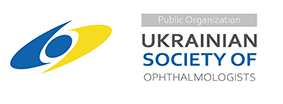Duration of the hypotensive effect of modified transscleral cyclophotocoagulation in patients with diabetic neovascular glaucoma
DOI:
https://doi.org/10.31288/oftalmolzh20252916Keywords:
diabetes mellitus, proliferative diabetic retinopathy, neovascular glaucoma, retina, ciliary body, cyclophotocoagulationAbstract
Purpose: To determine the duration of the hypotensive effect of the modified transscleral cyclophotocoagulation (TSCPC) with an 810-nm laser (1.5 J/ pulse) versus a 1064-nm laser (1.0 J/ pulse) followed by a 12-month follow-up in patients with diabetic neovascular glaucoma (NVG), and to assess the need for repeat TSCPC.
Material and Methods: This prospective open-label study included patients with diabetic NVG with a follow-up of 12 months. Proliferative diabetic retinopathy (DR) was found in 31/46 patients (67%) and the fundus could not be visualized in 15/46 patients (33%). Nine patients (20%) had a history or retinal laser photocoagulation and no pattern vision. All patients received TSCPC with a diode laser (810 nm, 1.5 J/ pulse) or neodymium:yttrium-aluminum-garnet (Nd:YAG) laser (1064 nm, 1.0 J/ pulse). TSCPC success was defined as an IOP between 10 and 21 mmHg (or a reduction in IOP of ≥ 30% from baseline IOP), no ocular pain, and an improvement or no change in best-corrected visual acuity.
Results: There was no statistically significant difference (р = 0.87) in the duration of hypotensive effect in NVG patients between diode-laser TSCPC and Nd:YAG-laser TSCPC. At 12 months, IOP was ≤ 21.0 mmHg in eyes of 18/24 patients (75%) in group 1 (1064 nm) versus 17/22 patients (75%) in group 2 (810 nm). The regression model for predicting the need of repeat TSCPC in diabetic patients with NVG based on baseline IOP, presence of ocular complications of NVG, and ocular pain score and diabetes duration explained 94% of the variation in outcome (Nagelkerke's R2 = 0.94), and the model accuracy, sensitivity and specificity were 96.2% (p < 0.001), 0.958 and 0.882, respectively.
Conclusion: At 12 months, stable ocular hypotensive effect of the modified TSCPC with an 810-nm laser (1.5 J/ pulse) and a 1064-nm laser (1.0 J/ pulse) was observed in 77% and 75%, respectively, of diabetic patients with NVG. The independent variables with the largest impact on the need for repeat TSCPC in diabetic patients with NVG were the baseline pain numeric rating scale score ≥ 8 (odds ratio (OR), 4.0; 95% confidence interval (CI), 1.84-8.91), presence of ocular complications (OR, 3.02; 95% CI, 1.84-8.91), diabetes duration ≥7 years (OR, 2.03; 95% CI, 1.46-2.28) and IOP ≥35 mmHg (OR, 1.16; 95% CI, 1.4-3.3).
References
Guzun O, Zadorozhnyy O, Wael C. Current Strategy of Treatment for Neovascular Glaucoma Secondary to Retinal Ischemic Lesions. J Ophthalmol (Ukraine). 2024;2:32-39. https://doi.org/10.31288/oftalmolzh202423239
Anand N, Klug E, Nirappel A, Solá-Del Valle D. A Review of Cyclodestructive Procedures for the Treatment of Glaucoma. Semin Ophthalmol. 2020 Aug 17;35(5-6):261-275. https://doi.org/10.1080/08820538.2020.1810711
Dastiridou AI, Katsanos A, Denis P, Francis BA, Mikropoulos DG, Teus MA, et al. Cyclodestructive Procedures in Glaucoma: A Review of Current and Emerging Options. Adv Ther. 2018 Dec;35(12):2103-2127. https://doi.org/10.1007/s12325-018-0837-3
Pastor SA, Singh K, Lee DA, Juzych MS, Lin SC, Netland PA, et al. Cyclophotocoagulation: a report by the American Academy of Ophthalmology. Ophthalmology. 2001 Nov;108(11):2130-8. https://doi.org/10.1016/S0161-6420(01)00889-2
Walland MJ. Diode laser cyclophotocoagulation: longer term follow up of a standardized treatment protocol. Clin Exp Ophthalmol. 2000;28(4):263-267. https://doi.org/10.1046/j.1442-9071.2000.00320.x
Guzun O.V., Zadorozhnyy O.S., Chechyn P.P., Artеmov A.V., Chargui Wael, Korol A.R. Histopathological changes in the eyes of rabbits after transscleral diode cyclophotocoagulation. Odesa Medical Journal. 2024. № 4 (189): 13-18. https://doi.org/10.32782/2226-2008-2024-4-2
Guzun OV, Zadorozhnyy OS, Chechin PP, Artemov OV, Chargui W, Korol AR. Comparing histopathological effects of the neodymium and diode laser transscleral cyclophotocoagulation: an experimental study. J.ophthalmol. (Ukraine). 2024;5:32-7.
Guzun O, Zadorozhnyy O, Nasinnyk I, Chargui W, Oueslati Y, Korol A. Efficacy of Nd:YAG and diode laser transscleral cyclophotocoagulation in the management of neovascular glaucoma associated with proliferative diabetic retinopathy. J.ophthalmol. (Ukraine). 2024;3:8-15. https://doi.org/10.31288/oftalmolzh20243815
Hanyuda A, Sawada N, Yuki K, Uchino M, Ozawa Y, Sasaki M, et al. Relationships of diabetes and hyperglycaemia with intraocular pressure in a Japanese population: the JPHC-NEXT Eye Study. Sci Rep. 2020 Mar 24;10(1):5355. https://doi.org/10.1038/s41598-020-62135-3
Diep TM, Tsui I. Risk factors associated with diabetic macular edema. Diabetes Res Clin Practice. 2013 Jun; 100 (3):298-305. https://doi.org/10.1016/j.diabres.2013.01.01
Kamoi K. Identifying risk factors for clinically significant diabetic macula edema in patients with type 2 diabetes mellitus. Curr. Diabetes Rev. 2013; 9 (3):209-17. https://doi.org/10.2174/1573399811309030002
Guzun OV, Zadorozhnyy OS, Velychko LM, Bogdanova OV, Dumbrăveanu LG, Cuşnir VV, Korol AR. The effect of the intercellular adhesion molecule-1 and glycated haemoglobin on the management of diabetic neovascular glaucoma. Rom J Ophthalmol. 2024 Apr-Jun;68(2):135-142. https://doi.org/10.22336/rjo.2024.25
Hawker GA, Mian S, Kendzerska T, French M. Measures of adult pain: Visual Analog Scale for Pain (VAS Pain), Numeric Rating Scale for Pain (NRS Pain), McGill Pain Questionnaire (MPQ), Short-Form McGill Pain Questionnaire (SF-MPQ), Chronic Pain Grade Scale (CPGS), Short Form-36 Bodily Pain Scale (SF-36 BPS), and Measure of Intermittent and Constant Osteoarthritis Pain (ICOAP). Arthritis Care Res (Hoboken). 2011;63(11):S240-52. https://doi.org/10.1002/acr.20543
Vaidya R, Washington A, Stine S, Geamanu A, Hudson I. The IPA, a Modified Numerical System for Pain Assessment and Intervention. J Am Acad Orthop Surg Glob Res Rev. 2021;5(9):e21.00174. https://doi.org/10.5435/JAAOSGlobal-D-21-00174
Zadorozhnyy O, Guzun O, Kustryn T, Nasinnyk I, Chechin P, Korol A. Targeted transscleral laser photocoagulation of the ciliary body in patients with neovascular glaucoma. J Ophthalmol (Ukraine). 2019;4:3-7. https://doi.org/10.31288/oftalmolzh2019437
Bernardi E, Töteberg-Harms M. MicroPulseTransscleral Laser Therapy Demonstrates Similar Efficacy with a Superior and More Favorable Safety Profile Compared to Continuous-Wave Transscleral Cyclophotocoagulation. J Ophthalmol. 2022;8566044. https://doi.org/10.1155/2022/8566044
Fong YYY, Wong BKT, Li FCH, Young AL. A Retrospective Study of Transscleral Cyclophotocoagulation Using the Slow Coagulation Technique for the Treatment of Refractory Glaucoma. Semin Ophthalmol. 2019;34(5):398-402. https://doi.org/10.1080/08820538.2019.1638946
Moussa K, Feinstein M, Pekmezci M, et al. Histologic Changes Following Continuous Wave and Micropulse Transscleral Cyclophotocoagulation: A Randomized Comparative Study. Transl Vis Sci Technol. 2020;9(5):22. https://doi.org/10.1167/tvst.9.5.22
Mohapatra A, Sudharshan S, Majumder PD, Sreenivasan J, Raman R. Clinical Profile and Ocular Morbidities in Patients with Both Diabetic Retinopathy and Uveitis. Ophthalmol Sci. 2024 Mar 7;4(6):100511. https://doi.org/10.1016/j.xops.2024.100511
Duerr ER, Sayed MS, Moster S, Holley T, Peiyao J, Vanner EA, et al. Transscleral Diode Laser Cyclophotocoagulation: A Comparison of Slow Coagulation and Standard Coagulation Techniques. Ophthalmol Glaucoma. 2018 Sep-Oct;1(2):115-122. https://doi.org/10.1016/j.ogla.2018.08.007
Sun C, Zhang H, Jiang J, Li Y, Nie C, Gu J, et al. Angiogenic and inflammatory biomarker levels in aqueous humor and vitreous of neovascular glaucoma and proliferative diabetic retinopathy. Int Ophthalmol. 2020 Feb;40(2):467-475. https://doi.org/10.1007/s10792-019-01207-4
Hwang YH, Lee S, Kim M, Choi J. Comparison of treatment outcomes between slow coagulation transscleral cyclophotocoagulation and micropulse transscleral laser treatment. Sci Rep. 2024 Oct 13;14(1):23944. https://doi.org/10.1038/s41598-024-75246-y
Parekh Z, Wang J, Qiu M. Outcomes of slow coagulation transscleral cyclophotocoagulation in a predominantly African American glaucoma population. Am J Ophthalmol Case Rep. 2024 May 22;35:102072. https://doi.org/10.1016/j.ajoc.2024.102072
Khodeiry MM, Liu X, Lee RK. Clinical outcomes of slow-coagulation continuous-wave transscleral cyclophotocoagulation laser for treatment of glaucoma. Curr Opin Ophthalmol. 2022 May 1;33(3):237-242. https://doi.org/10.1097/ICU.0000000000000837
Downloads
Published
How to Cite
Issue
Section
License
Copyright (c) 2025 Guzun O.V., Zadorozhnyy O.S., Nasinnyk I.O., Wael Chargui, Korol A.R.

This work is licensed under a Creative Commons Attribution 4.0 International License.
This work is licensed under a Creative Commons Attribution 4.0 International (CC BY 4.0) that allows users to read, download, copy, distribute, print, search, or link to the full texts of the articles, or use them for any other lawful purpose, without asking prior permission from the publisher or the author as long as they cite the source.
COPYRIGHT NOTICE
Authors who publish in this journal agree to the following terms:
- Authors hold copyright immediately after publication of their works and retain publishing rights without any restrictions.
- The copyright commencement date complies the publication date of the issue, where the article is included in.
DEPOSIT POLICY
- Authors are permitted and encouraged to post their work online (e.g., in institutional repositories or on their website) during the editorial process, as it can lead to productive exchanges, as well as earlier and greater citation of published work.
- Authors are able to enter into separate, additional contractual arrangements for the non-exclusive distribution of the journal's published version of the work with an acknowledgement of its initial publication in this journal.
- Post-print (post-refereeing manuscript version) and publisher's PDF-version self-archiving is allowed.
- Archiving the pre-print (pre-refereeing manuscript version) not allowed.












